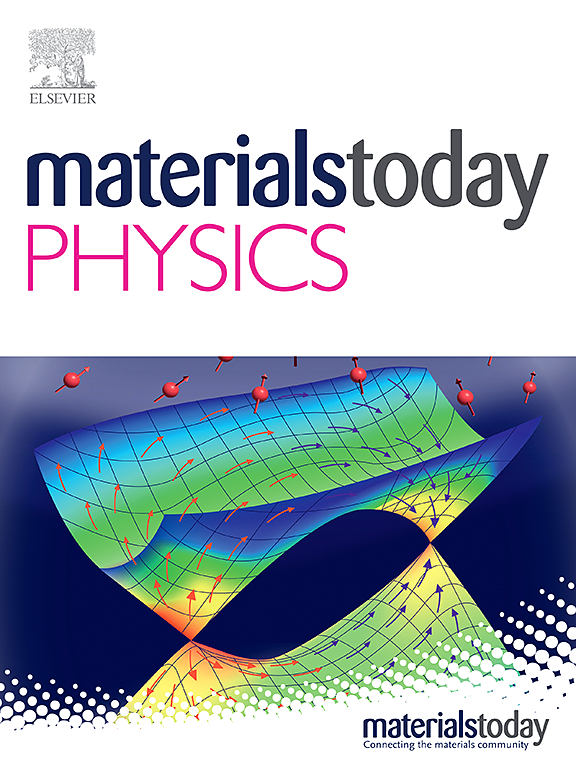Prediction of high-temperature superconductors with Tc up to 214.3 K in Mg-Zr-H ternary hydrides
IF 10
2区 材料科学
Q1 MATERIALS SCIENCE, MULTIDISCIPLINARY
引用次数: 0
Abstract
Ternary hydrides, with richer chemical compositions and structures compared to binary hydrides due to their high degrees of freedom, are expected to contain more candidates for high- superconductors with remarkable properties including higher and lower stabilizing pressures. In this work, the high-pressure structures, electronic properties, and superconductivity of MgZrH (-6) ternary system are investigated by combining the prediction method of particle swarm optimization algorithm and first-principles calculations. We find thermodynamically stable structures for MgZrH, MgZrH, and MgZrH, respectively, while only metastable structures for . During the predicted structures, our analysis mainly focuses on -MgZrH, -MgZrH, -MgZrH, and -MgZrH12. -MgZrH and -MgZrH exhibit a low of 0.006 K at 40 GPa and 0.95 K at ambient pressure, respectively, due to low electronic contribution from hydrogen at the Fermi level. -MgZrH shows a higher of 80.3 K at 36 GPa, primarily influenced by softened phonon modes and a high Hopfield ratio . Furthermore, the superconducting figure of merit of -MgZrH is , significantly larger than that of MgB. Remarkably, -MgZrH12 is a high- superconductor with a up to 214.3 K at 300 GPa, due to its high hydrogen content and significant electronic contribution from hydrogen at the Fermi level. Our study provides valuable insights for future experiments and can serve as a useful reference for exploring potential high-temperature superconductors in ternary hydrides.
Mg-Zr-H三元氢化物中Tc高达214.3 K的高温超导体的预测
与二元氢化物相比,三元氢化物由于其高度的自由度,具有更丰富的化学成分和结构,有望包含更多的高TcTc超导体候选材料,具有更高的TcTc和更低的稳定压力等卓越性能。本文采用粒子群优化算法和第一性原理计算相结合的预测方法,研究了MgZrH2n2n (n=1n=1-6)三元体系的高压结构、电子性能和超导性。我们分别发现了MgZrH22、MgZrH44和MgZrH66的热力学稳定结构,而对于n或或或或或或或或或或或或或或或或或或或或或或或或或或或或或或或或或或或或或或或或或或或或或或或或或或或或或或或或或或在预测结构中,我们的分析主要集中在P63/mmcP63/mmc-MgZrH22、R3’mR3’m-MgZrH44、Pm3’Pm3’m -MgZrH66和Fd3’mFd3’m-MgZrH12。P63/mmcP63/mmc-MgZrH22和R3 / mR3 / m-MgZrH44在40 GPa和环境压力下分别表现出0.006 K和0.95 K的低TcTc,这是由于氢在费米能级上的低电子贡献。Pm3 / Pm3 -MgZrH66在36 GPa时TcTc高达80.3 K,主要受声子模式软化和Hopfield比值I2/MI2/M的影响。Pm3 - Pm3 -MgZrH66的超导优值为S=1.51S=1.51,显著大于MgB22。值得注意的是,Fd3 / mFd3 / m-MgZrH12是一种高TcTc超导体,在300 GPa时TcTc高达214.3 K,这是由于它的高氢含量和费米能级上氢的显著电子贡献。我们的研究为未来的实验提供了有价值的见解,可以为探索三元氢化物中潜在的高温超导体提供有用的参考。
本文章由计算机程序翻译,如有差异,请以英文原文为准。
求助全文
约1分钟内获得全文
求助全文
来源期刊

Materials Today Physics
Materials Science-General Materials Science
CiteScore
14.00
自引率
7.80%
发文量
284
审稿时长
15 days
期刊介绍:
Materials Today Physics is a multi-disciplinary journal focused on the physics of materials, encompassing both the physical properties and materials synthesis. Operating at the interface of physics and materials science, this journal covers one of the largest and most dynamic fields within physical science. The forefront research in materials physics is driving advancements in new materials, uncovering new physics, and fostering novel applications at an unprecedented pace.
 求助内容:
求助内容: 应助结果提醒方式:
应助结果提醒方式:


